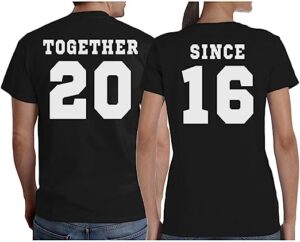The Art of Matching Shirts: Elevate Your Style with Perfect Pairings
 Matching shirts are the unsung heroes of any stylish wardrobe, as they have the power to enhance your appearance, showcase your personality, and make a lasting impression. Whether you’re dressing up for a formal occasion or aiming for a casual yet polished look, understanding the art of coordinating a matching shirt is key. In this blog post, we’ll delve into the nuances of selecting and coordinating shirts to help you elevate your style game.
Matching shirts are the unsung heroes of any stylish wardrobe, as they have the power to enhance your appearance, showcase your personality, and make a lasting impression. Whether you’re dressing up for a formal occasion or aiming for a casual yet polished look, understanding the art of coordinating a matching shirt is key. In this blog post, we’ll delve into the nuances of selecting and coordinating shirts to help you elevate your style game.
Understanding Color Theory:
Color plays a pivotal role in fashion, and mastering color theory is essential when it comes to matching shirts. Start by understanding the basic color wheel, which consists of primary (red, blue, yellow), secondary (orange, green, purple), and tertiary colors. Complementary colors lie opposite each other on the wheel, such as blue and orange or red and green. These combinations create a vibrant and visually appealing contrast. Analogous colors, on the other hand, are adjacent on the wheel, like blue and green or red and purple, offering a more harmonious blend.
Harmonizing with Skin Tone:
 While color theory provides a framework, it’s crucial to consider your skin tone when matching shirts. Warm skin tones (with yellow or golden undertones) tend to complement earthy hues like olive green, burnt orange, or mustard yellow. Cool skin tones (with pink or blue undertones) harmonize well with jewel tones like sapphire blue, emerald green, or ruby red. Experiment with different shades to find what suits you best and brings out your natural complexion.
While color theory provides a framework, it’s crucial to consider your skin tone when matching shirts. Warm skin tones (with yellow or golden undertones) tend to complement earthy hues like olive green, burnt orange, or mustard yellow. Cool skin tones (with pink or blue undertones) harmonize well with jewel tones like sapphire blue, emerald green, or ruby red. Experiment with different shades to find what suits you best and brings out your natural complexion.
The Classic White Shirt:
The white shirt is a timeless staple in any wardrobe, and its versatility makes it an essential piece for various occasions. Pair it with navy blue trousers for a classic, professional look or wear it untucked with jeans for a casual yet refined style. The key is to ensure the white shirt fits well and complements your body shape, as an ill-fitting shirt can undermine your overall appearance.
Pattern Play:
Patterns add depth and interest to any outfit, but they require careful coordination to avoid overwhelming the ensemble. When matching patterned shirts, aim for complementary patterns rather than competing ones. For instance, if you’re wearing a striped shirt, pair it with a solid-colored tie or vice versa. When mixing patterns, ensure there is enough contrast to create visual balance. For example, a subtle pinstripe suit can be paired with a bold checkered shirt for a confident and fashionable look.
Formal vs. Casual:
Matching shirts for formal occasions demands a different approach compared to casual attire. In formal settings, opt for classic solid colors, subtle patterns, or understated stripes. A well-tailored shirt in white, light blue, or soft pink can be paired with a suit or blazer for a sophisticated look. Casual outfits allow for more experimentation. Try pairing a chambray shirt with khaki chinos for a laid-back yet stylish vibe or opt for a linen shirt with shorts for a cool summer look.
Layering for Depth:
 Layering is a fantastic technique to add dimension and style to your outfit. A solid-colored shirt can serve as a canvas for layering different textures, colors, and patterns. For instance, pair a denim shirt with a lightweight cardigan or a plaid shirt with a contrasting blazer. Experiment with different combinations to create a layered ensemble that reflects your personal style and keeps you comfortable in changing weather conditions.
Layering is a fantastic technique to add dimension and style to your outfit. A solid-colored shirt can serve as a canvas for layering different textures, colors, and patterns. For instance, pair a denim shirt with a lightweight cardigan or a plaid shirt with a contrasting blazer. Experiment with different combinations to create a layered ensemble that reflects your personal style and keeps you comfortable in changing weather conditions.
Matching shirts is an art form that allows you to express your personality and create memorable looks. By understanding color theory, harmonizing with your skin tone, and considering the occasion, you can effortlessly elevate your style game. Remember to experiment, trust your instincts, and have fun with your choices. With a little practice and an eye for detail, you’ll become a master of matching shirts, leaving a lasting impression wherever you go.